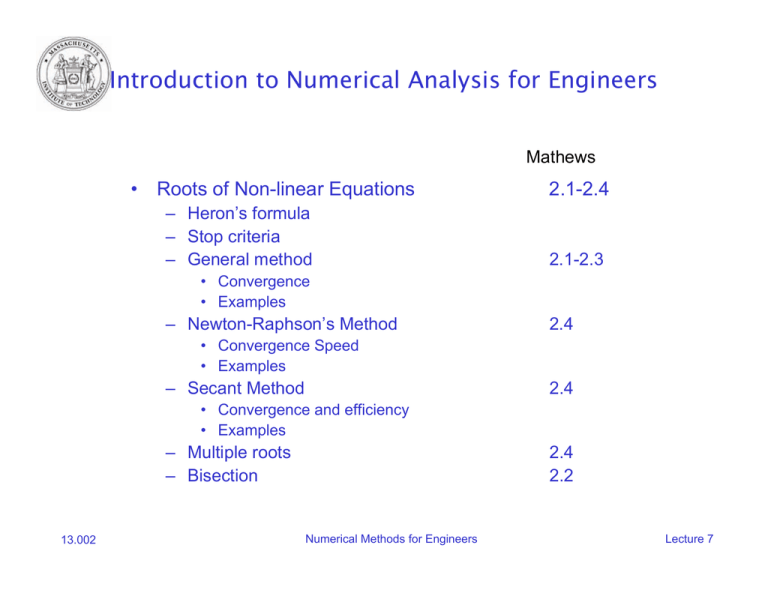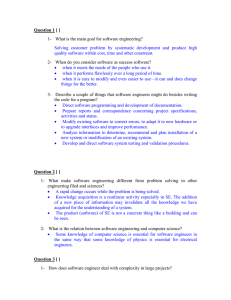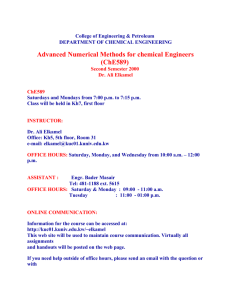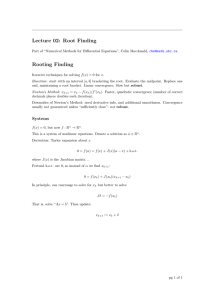Introduction to Numerical Analysis for Engineers • Roots of Non-linear Equations 2.1-2.4
advertisement

Introduction to Numerical Analysis for Engineers
Mathews
•
Roots of Non-linear Equations
– Heron’s formula
– Stop criteria
– General method
• Convergence
• Examples
2.1-2.3
– Newton-Raphson’s Method
2.4
– Secant Method
2.4
– Multiple roots
– Bisection
2.4
2.2
• Convergence Speed
• Examples
• Convergence and efficiency
• Examples
13.002
2.1-2.4
Numerical Methods for Engineers
Lecture 7
Roots of Nonlinear Equations
Example – Square root
Heron’s Principle
a=2;
n=6;
heron.m
g=2;
% Number of Digits
dig=5;
sq(1)=g;
for i=2:n
sq(i)= 0.5*radd(sq(i-1),a/sq(i-1),dig);
end
'
i
value
'
[ [1:n]' sq']
hold off
plot([0 n],[sqrt(a) sqrt(a)],'b')
hold on
plot(sq,'r')
plot(a./sq,'r-.')
plot((sq-sqrt(a))/sqrt(a),'g')
grid on
Guess root
Mean is better guess
(
)/2
i
value
1.0000
2.0000
3.0000
4.0000
5.0000
6.0000
2.0000
1.5000
1.4167
1.4143
1.4143
1.4143
Iteration Formula
13.002
(
)/2
Numerical Methods for Engineers
Lecture 7
Roots of Nonlinear Equations
Stop-criteria
Unrealistic stop-criteria
Realistic stop-criteria
Machine
Accuracy
Use combination of the two criteria
f(x)
f(x)
‘flat’ f(x)
‘steep’ f(x)
G
x
x
Cannot require
Cannot require
G
13.002
Numerical Methods for Engineers
Lecture 7
Roots of Nonlinear Equations
General Method
Example: Cube root
Non-linear Equation
Goal: Converging series
Rewrite Problem
Example
% f(x) = x^3 - a = 0
% g(x) = x + C*(x^3 - a)
cube.m
a=2;
n=10;
g=1.0;
C=-0.1;
sq(1)=g;
for i=2:n
sq(i)= sq(i-1) + C*(sq(i-1)^3 -a);
end
hold off
plot([0 n],[a^(1./3.) a^(1/3.)],'b')
hold on
plot(sq,'r')
plot( (sq-a^(1./3.))/(a^(1./3.)),'g')
grid on
Iteration
13.002
Numerical Methods for Engineers
Lecture 7
Roots of Nonlinear Equations
General Method
Convergence
Define k such that if
y
then
Convergence Criteria
Apply successively
x
13.002
Numerical Methods for Engineers
Convergence
Lecture 7
Roots of Nonlinear Equations
General Method
Convergence
y=x
y
Convergent
y=g(x)
Mean-value Theorem
x1
x0
x
Convergence
y
>
y=x
y=g(x)
Divergent
x0 x1
13.002
Numerical Methods for Engineers
x
Lecture 7
Roots of Nonlinear Equations
General Method
n=10;
g=1.0;
cube.m
C=-0.21;
sq(1)=g;
for i=2:n
sq(i)= sq(i-1) + C*(sq(i-1)^3 -a);
end
hold off
f=plot([0 n],[a^(1./3.) a^(1/3.)],'b')
set(f,'LineWidth',2);
hold on
f=plot(sq,'r')
set(f,'LineWidth',2);
f=plot( (sq-a^(1./3.))/(a^(1./3.)),'g')
set(f,'LineWidth',2);
legend('Exact','Iteration','Error');
f=title(['a = ' num2str(a) ', C = ' num2str(C)])
set(f,'FontSize',16);
grid on
Example: Cube root
Rewrite
Convergence
Converges more rapidly for small
13.002
Numerical Methods for Engineers
Lecture 7
Roots of Nonlinear Equations
General Method
Converging, but how close?
Absolute error
General Convergence Rule
13.002
Numerical Methods for Engineers
Lecture 7
Roots of Nonlinear Equations
Newton-Raphson Method
Non-linear Equation
Convergence Criteria
f(x)
Fast Convergence
x
Newton-Raphson Iteration
13.002
Numerical Methods for Engineers
Lecture 7
Roots of Nonlinear Equations
Newton-Raphson Method
Example – Square Root
Newton-Raphson
a=26;
n=10;
sqr.m
g=1;
sq(1)=g;
for i=2:n
sq(i)= 0.5*(sq(i-1) + a/sq(i-1));
end
hold off
plot([0 n],[sqrt(a) sqrt(a)],'b')
hold on
plot(sq,'r')
plot(a./sq,'r-.')
plot((sq-sqrt(a))/sqrt(a),'g')
grid on
Same as Heron’s formula
13.002
Numerical Methods for Engineers
Lecture 7
Roots of Nonlinear Equations
Newton-Raphson Method
Approximate Guess
a=10;
n=10;
div.m
g=0.19;
sq(1)=g;
for i=2:n
sq(i)=sq(i-1) - sq(i-1)*(a*sq(i-1) -1) ;
end
hold off
plot([0 n],[1/a 1/a],'b')
hold on
plot(sq,'r')
plot((sq-1/a)*a,'g')
grid on
legend('Exact','Iteration','Error');
title(['x = 1/' num2str(a)])
Newton-Raphson
13.002
Numerical Methods for Engineers
Lecture 7
Roots of Nonlinear Equations
Newton-Raphson Method
Convergence Speed
Taylor Expansion
Second Order Expansion
Relative Error
Quadratic Convergence
General Convergence Rate
Convergence Exponent
13.002
Numerical Methods for Engineers
Lecture 7
Roots of Nonlinear Equations
Secant Method
1.
In Newton-Raphson we have to evaluate 2 functions
2.
may not be given in closed, analytical form, i.e. it may be a
result of a numerical algorithm
Approximate Derivative
f(x)
Secant Method Iteration
x
Only 1 function call per iteration:
13.002
Numerical Methods for Engineers
Lecture 7
Roots of Nonlinear Equations
Secant Method
Convergence Speed
Absolute Error
Error Exponent
Taylor Series – 2nd order
1
Relative Error
Error improvement for each function call
Secant Method
Newton-Raphson
Exponents called Efficiency Index
13.002
Numerical Methods for Engineers
Lecture 7
Roots of Nonlinear Equations
Multiple Roots
p-order Root
Newton-Raphson
=>
f(x)
Convergence
x
Slower convergence the higher the order of the root
13.002
Numerical Methods for Engineers
Lecture 7
Roots of Nonlinear Equations
Bisection
Algorithm
f(x)
n = n+1
x
yes
no
13.002
Less efficient than Newton-Raphson and
Secant methods, but often used to isolate
interval with root and obtain approximate
value. Then followed by N-R or Secant
method for accurate root.
Numerical Methods for Engineers
Lecture 7
Roots of Nonlinear Equations
Bisection
% Root finding by bi-section
f=inline(' a*x -1','x','a');
bisect.m
a=2
figure(1); clf; hold on
x=[0 1.5]; eps=1e-3;
err=max(abs(x(1)-x(2)),abs(f(x(1),a)-f(x(2),a)));
while (err>eps & f(x(1),a)*f(x(2),a) <= 0)
xo=x; x=[xo(1) 0.5*(xo(1)+xo(2))];
if ( f(x(1),a)*f(x(2),a) > 0 )
x=[0.5*(xo(1)+xo(2)) xo(2)]
end
x
err=max(abs(x(1)-x(2)),abs(f(x(1),a)-f(x(2),a)));
b=plot(x,f(x,a),'.b'); set(b,'MarkerSize',20);
grid on;
end
Algorithm
n = n+1
yes
no
13.002
Numerical Methods for Engineers
Lecture 7





